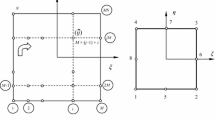Summary
Starting from the variational principle with the so-called hybrid stress method the trial functions for the stresses have now to fulfill the Beltrami-equations, that means also the compatibility equations for the strains. So the divergence theorem can be applied, and one arrives at a pure boundary formulation in the sense of Trefftz’s method. Beside the resulting variational formulation different regularizations of the interelement conditions are investigated by numerical tests. Two 3d-examples are presented, one to show the effects on distorted elements and the other for numerical comparison of the test of a composite box girder with inner steel flanges. The numerical efficiency in comparing with competing finite elements is promising and stimulates further research.
Access this chapter
Tax calculation will be finalised at checkout
Purchases are for personal use only
Preview
Unable to display preview. Download preview PDF.
Similar content being viewed by others
References
Pian, T. H. H. — Derivation of element stiffness matrices by assumed stress distributions. AIAA-J. 2, No. 7, 1333–1336, 1964
Trefftz, E. — Ein Gegenstück zum Ritzschen Verfahren. Verhandlungen des 2. internationalen Kongresses für technische Mechanik Zürich, 131–137, 1926.
Stein, E. — Die Kombination des modifizierten Trefftzschen Verfahrens mit der Methode der finiten Elemente. Finite Elemente in der Statik, Ed. Brück, K.E. and Scharpf, D.W. and Stein, E., Verlag Wilhelm Ernst & Sohn, Berlin 1973, p. 172–185 and (with Ruoff) 242–259.
Jirousek, J. — The hybrid-trefftz finite element model and its application to plate bending. Int. J. Num. Meth. Eng., 23, 651–693, 1986.
Cheung, Y.K. and Wanji, J.C. — Isoparametric hybrid hexahedral elements for 3-d stress analysis. Int. J. Num. Meth. Eng., 26, p. 677–693, 1988.
Author information
Authors and Affiliations
Editor information
Rights and permissions
Copyright information
© 1991 Springer-Verlag Berlin Heidelberg
About this chapter
Cite this chapter
Stein, E., Peters, K. (1991). A New Boundary-Type Finite Element for 2D- and 3D-Elastic Solids. In: Oñate, E., Periaux, J., Samuelsson, A. (eds) The finite element method in the 1990’s. Springer, Berlin, Heidelberg. https://doi.org/10.1007/978-3-662-10326-5_5
Download citation
DOI: https://doi.org/10.1007/978-3-662-10326-5_5
Publisher Name: Springer, Berlin, Heidelberg
Print ISBN: 978-3-662-10328-9
Online ISBN: 978-3-662-10326-5
eBook Packages: Springer Book Archive




